PCD101 Place, Culture & Destination Management: Report on NSW Plan
VerifiedAdded on 2022/10/12
|11
|2065
|191
Report
AI Summary
This report, prepared for the PCD101 Place, Culture & Destination Management course, analyzes destination management plans with a focus on New South Wales (NSW). It examines the role and structure of destination management organizations (DMOs), their relationships with tourism stakeholders, and the objectives outlined in destination management plans. The report explores changing patterns and trends in global tourism, including the shift from tourists to travelers, the growth of solo and intergenerational travel, and the impact of technology. It further details the strategies employed by DMOs to market destinations, such as data-informed marketing and customer research, and concludes with a summary of key findings and references.
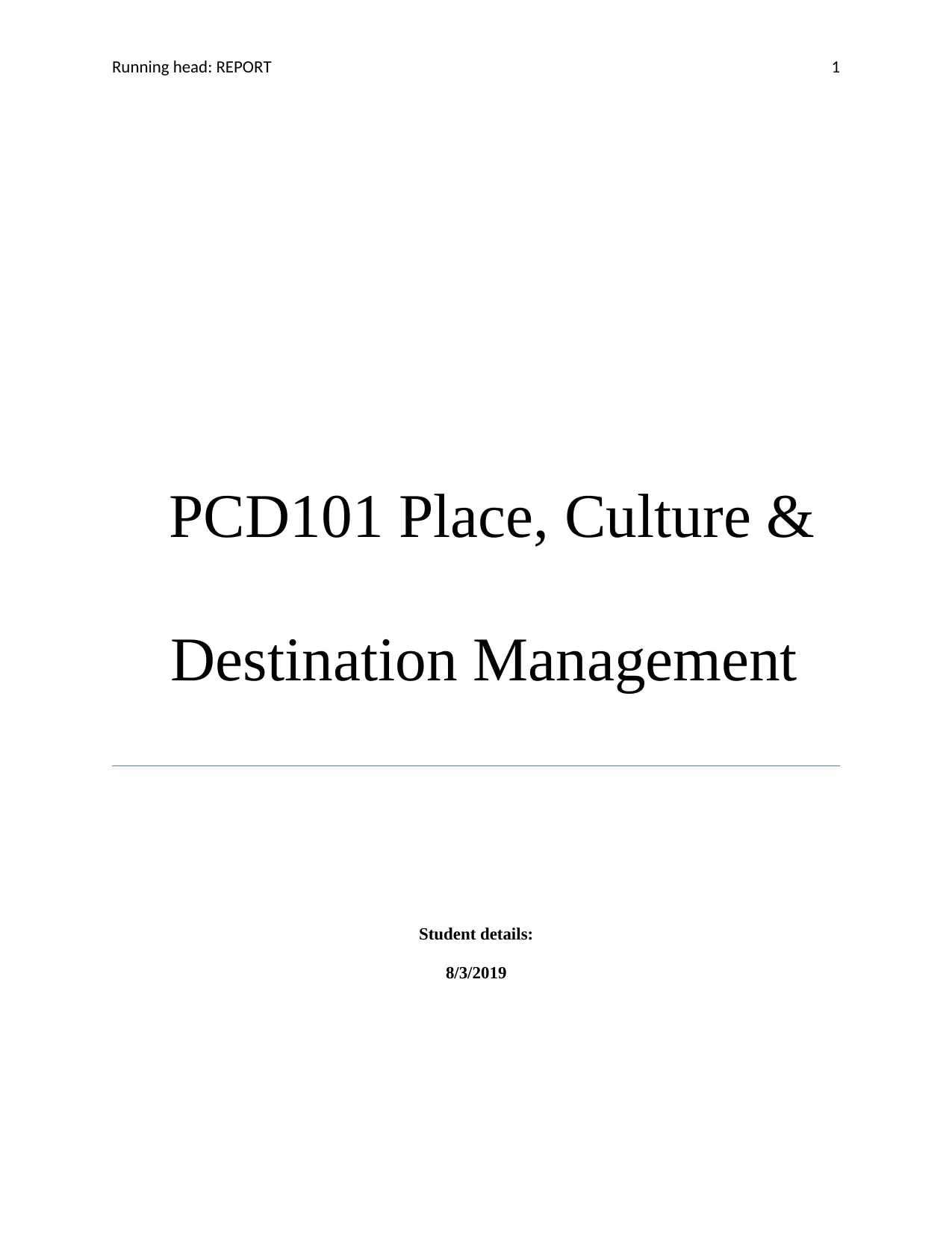
Running head: REPORT 1
PCD101 Place, Culture &
Destination Management
Student details:
8/3/2019
PCD101 Place, Culture &
Destination Management
Student details:
8/3/2019
Paraphrase This Document
Need a fresh take? Get an instant paraphrase of this document with our AI Paraphraser
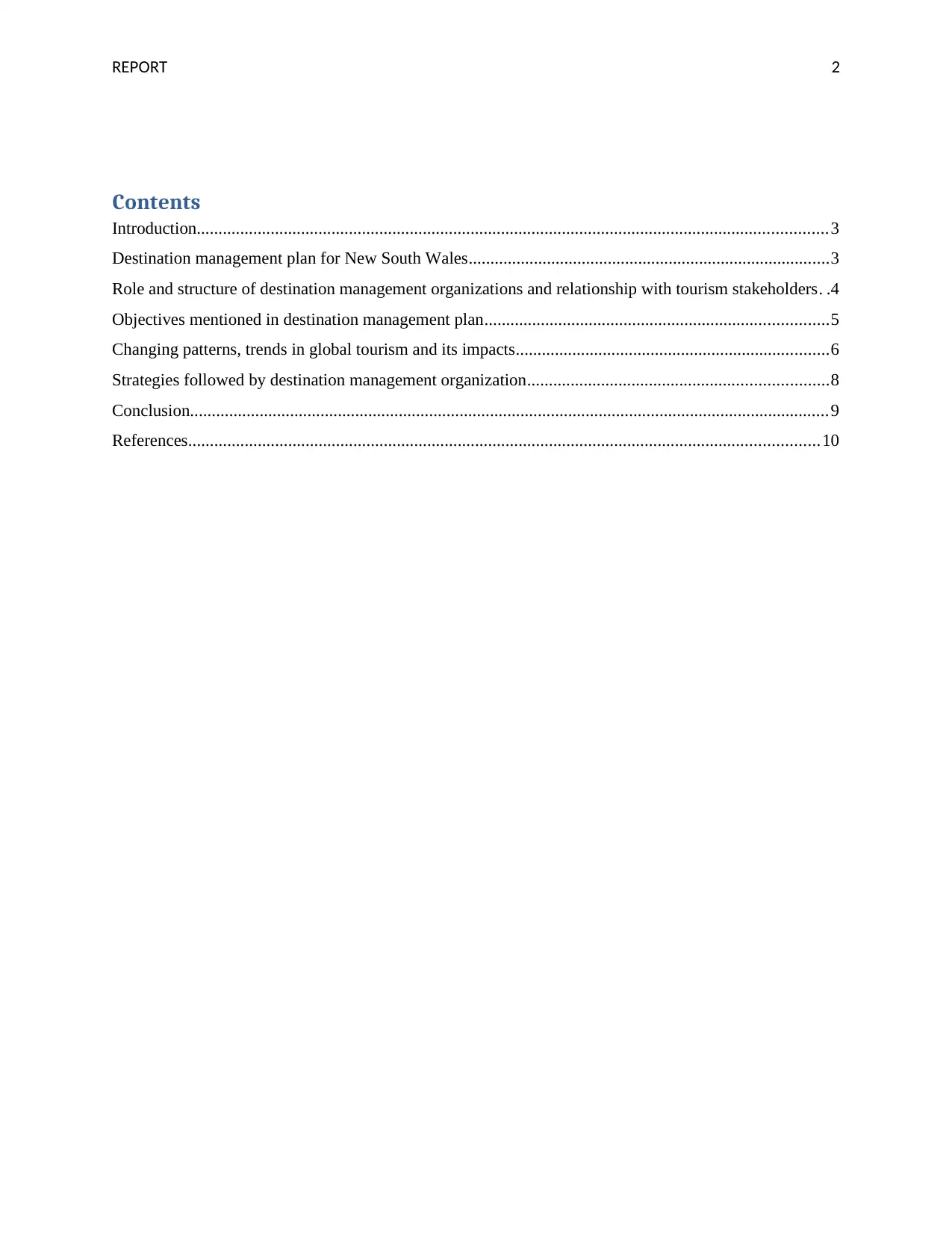
REPORT 2
Contents
Introduction.................................................................................................................................................3
Destination management plan for New South Wales...................................................................................3
Role and structure of destination management organizations and relationship with tourism stakeholders. .4
Objectives mentioned in destination management plan...............................................................................5
Changing patterns, trends in global tourism and its impacts........................................................................6
Strategies followed by destination management organization.....................................................................8
Conclusion...................................................................................................................................................9
References.................................................................................................................................................10
Contents
Introduction.................................................................................................................................................3
Destination management plan for New South Wales...................................................................................3
Role and structure of destination management organizations and relationship with tourism stakeholders. .4
Objectives mentioned in destination management plan...............................................................................5
Changing patterns, trends in global tourism and its impacts........................................................................6
Strategies followed by destination management organization.....................................................................8
Conclusion...................................................................................................................................................9
References.................................................................................................................................................10
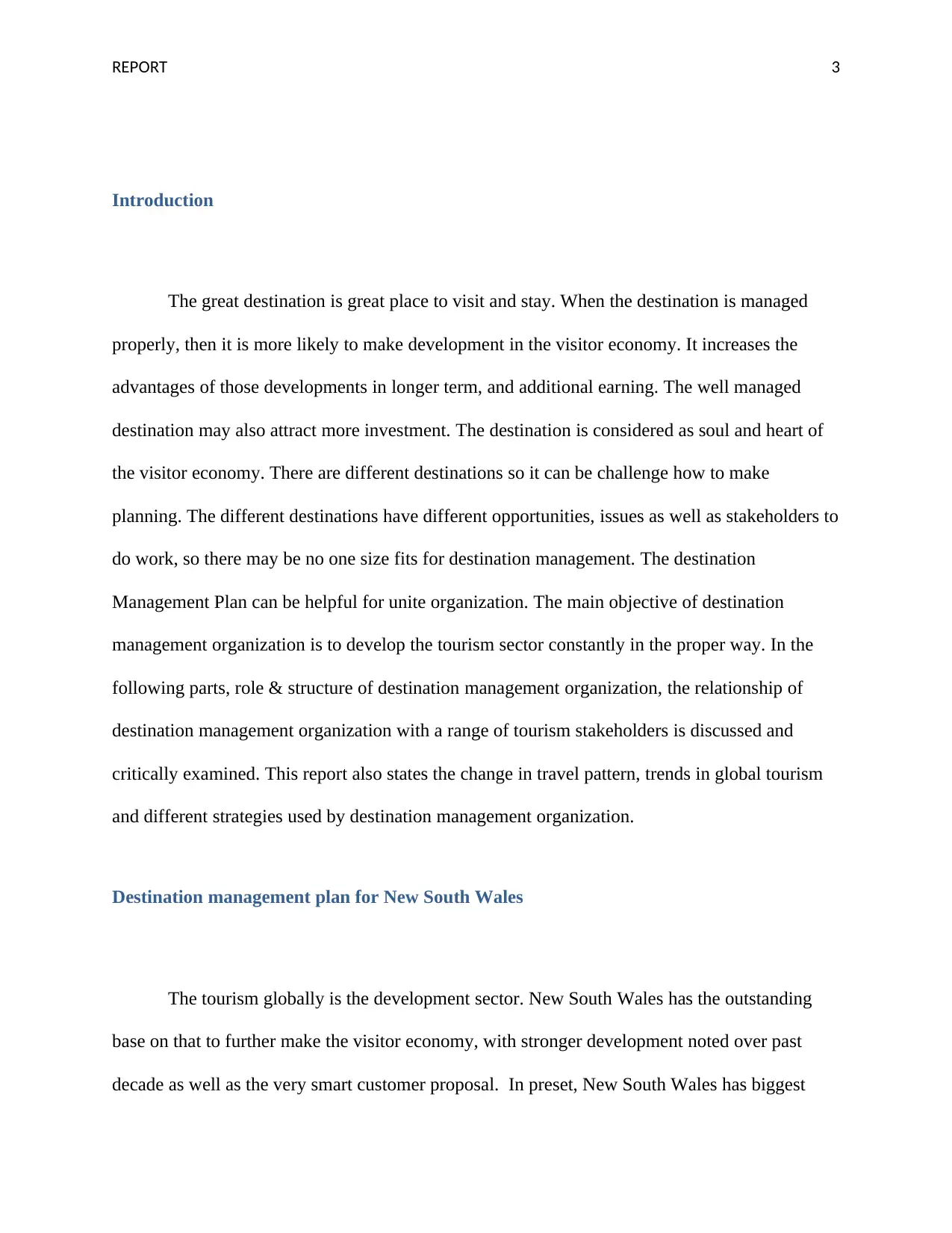
REPORT 3
Introduction
The great destination is great place to visit and stay. When the destination is managed
properly, then it is more likely to make development in the visitor economy. It increases the
advantages of those developments in longer term, and additional earning. The well managed
destination may also attract more investment. The destination is considered as soul and heart of
the visitor economy. There are different destinations so it can be challenge how to make
planning. The different destinations have different opportunities, issues as well as stakeholders to
do work, so there may be no one size fits for destination management. The destination
Management Plan can be helpful for unite organization. The main objective of destination
management organization is to develop the tourism sector constantly in the proper way. In the
following parts, role & structure of destination management organization, the relationship of
destination management organization with a range of tourism stakeholders is discussed and
critically examined. This report also states the change in travel pattern, trends in global tourism
and different strategies used by destination management organization.
Destination management plan for New South Wales
The tourism globally is the development sector. New South Wales has the outstanding
base on that to further make the visitor economy, with stronger development noted over past
decade as well as the very smart customer proposal. In preset, New South Wales has biggest
Introduction
The great destination is great place to visit and stay. When the destination is managed
properly, then it is more likely to make development in the visitor economy. It increases the
advantages of those developments in longer term, and additional earning. The well managed
destination may also attract more investment. The destination is considered as soul and heart of
the visitor economy. There are different destinations so it can be challenge how to make
planning. The different destinations have different opportunities, issues as well as stakeholders to
do work, so there may be no one size fits for destination management. The destination
Management Plan can be helpful for unite organization. The main objective of destination
management organization is to develop the tourism sector constantly in the proper way. In the
following parts, role & structure of destination management organization, the relationship of
destination management organization with a range of tourism stakeholders is discussed and
critically examined. This report also states the change in travel pattern, trends in global tourism
and different strategies used by destination management organization.
Destination management plan for New South Wales
The tourism globally is the development sector. New South Wales has the outstanding
base on that to further make the visitor economy, with stronger development noted over past
decade as well as the very smart customer proposal. In preset, New South Wales has biggest
⊘ This is a preview!⊘
Do you want full access?
Subscribe today to unlock all pages.

Trusted by 1+ million students worldwide

REPORT 4
tourism investment pipelines of other Australian states or regions. There are various chances to
attract the tourists to NSW as well as encourage them to stay at destination for long period. It is
the diverse tourism destination to be developed more by destination management organization, in
comparison of Sydney and other six regional destination networks. Moreover, the destination
management plan can be helpful to develop tourism in NSW. The destination management plan
states the challenges, opportunities as well as strategies. This destination management plan
focuses on city, short breaks, food as well as drink, family, nature, art and culture, farms stays,
cruise, health & well-being and camping. It also puts focus on education and business events
(Seraphin, Sheeran & Pilato, 2018).
Role and structure of destination management organizations and relationship with tourism
stakeholders
The destination management organization has significant role in developing destination
management plan to increase tourism. The role of destination management organization is to
draw the attention of tourists. It also provides the wonderful unforgettable experience for the
visitors to call them again. They have key role in encouraging the tourists to travel more and
search lesser well known destination (Mariani, Di Felice & Mura, 2016). The destination
management organization makes a destination management plan to describe the essence of
nation. It also sets the milestones, responsibilities, the performance indicator, performance’s
reporting from destinations. This destination management plan focuses on city, short breaks,
food as well as drink, family, nature, art and culture, farms stays, cruise, health & well-being and
camping. It also puts focus on education and business events. In addition of this, the destination
tourism investment pipelines of other Australian states or regions. There are various chances to
attract the tourists to NSW as well as encourage them to stay at destination for long period. It is
the diverse tourism destination to be developed more by destination management organization, in
comparison of Sydney and other six regional destination networks. Moreover, the destination
management plan can be helpful to develop tourism in NSW. The destination management plan
states the challenges, opportunities as well as strategies. This destination management plan
focuses on city, short breaks, food as well as drink, family, nature, art and culture, farms stays,
cruise, health & well-being and camping. It also puts focus on education and business events
(Seraphin, Sheeran & Pilato, 2018).
Role and structure of destination management organizations and relationship with tourism
stakeholders
The destination management organization has significant role in developing destination
management plan to increase tourism. The role of destination management organization is to
draw the attention of tourists. It also provides the wonderful unforgettable experience for the
visitors to call them again. They have key role in encouraging the tourists to travel more and
search lesser well known destination (Mariani, Di Felice & Mura, 2016). The destination
management organization makes a destination management plan to describe the essence of
nation. It also sets the milestones, responsibilities, the performance indicator, performance’s
reporting from destinations. This destination management plan focuses on city, short breaks,
food as well as drink, family, nature, art and culture, farms stays, cruise, health & well-being and
camping. It also puts focus on education and business events. In addition of this, the destination
Paraphrase This Document
Need a fresh take? Get an instant paraphrase of this document with our AI Paraphraser
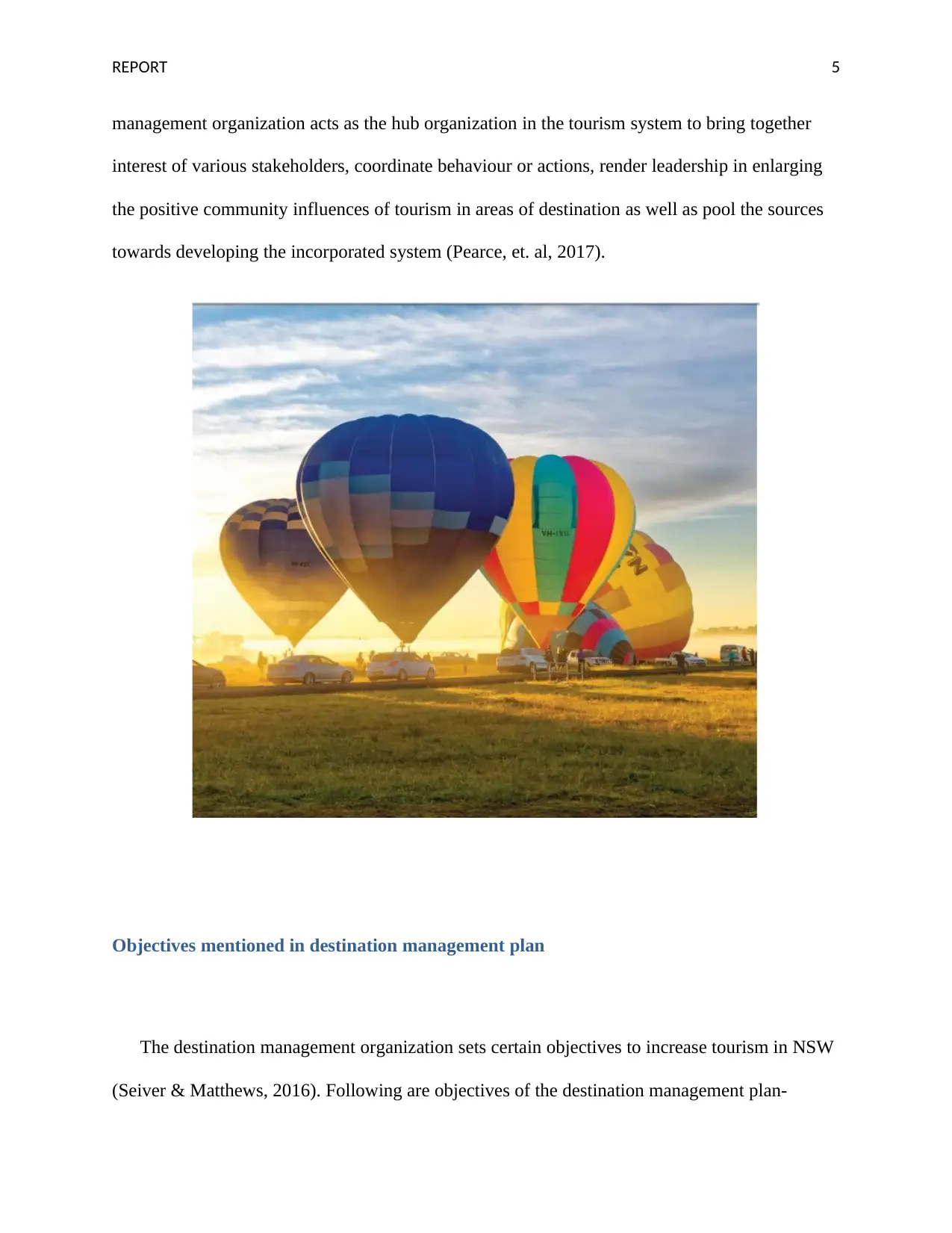
REPORT 5
management organization acts as the hub organization in the tourism system to bring together
interest of various stakeholders, coordinate behaviour or actions, render leadership in enlarging
the positive community influences of tourism in areas of destination as well as pool the sources
towards developing the incorporated system (Pearce, et. al, 2017).
Objectives mentioned in destination management plan
The destination management organization sets certain objectives to increase tourism in NSW
(Seiver & Matthews, 2016). Following are objectives of the destination management plan-
management organization acts as the hub organization in the tourism system to bring together
interest of various stakeholders, coordinate behaviour or actions, render leadership in enlarging
the positive community influences of tourism in areas of destination as well as pool the sources
towards developing the incorporated system (Pearce, et. al, 2017).
Objectives mentioned in destination management plan
The destination management organization sets certain objectives to increase tourism in NSW
(Seiver & Matthews, 2016). Following are objectives of the destination management plan-

REPORT 6
1. Make the New South Wales on number one position as world leading tourism as well as
event destination
2. Make the sustainable event calendar for New South Wales
3. Secure as well as attract high value major events
4. Enhance the involvement of customers
5. Increase the participation of industry stakeholders
6. Make delivery of the values in the partnership co-operative programs
7. Develop as well as maintain the higher performance organizations
8. Increase the yield as well as dispersal from the visitors economies
9. Better application of the visitors economy industry action plan
Changing patterns, trends in global tourism and its impacts
Internationally, the visitors are becoming increasingly complicated, well travelled and
requiring the destinations as well as products and experience accessible to them. The tourism
markets are very competitive, with certain two hundred nations actively competing for visitor
dollars. Following are the key global tourism and travel trends-
1. From tourists to travellers- the visitors are requiring the experience, which permit them to
get view of the regular life styles of the locals in Australia. The visitors get happiness in
exploring lesser known location for the better experiences. In this way, the tourists are
becoming travellers.
1. Make the New South Wales on number one position as world leading tourism as well as
event destination
2. Make the sustainable event calendar for New South Wales
3. Secure as well as attract high value major events
4. Enhance the involvement of customers
5. Increase the participation of industry stakeholders
6. Make delivery of the values in the partnership co-operative programs
7. Develop as well as maintain the higher performance organizations
8. Increase the yield as well as dispersal from the visitors economies
9. Better application of the visitors economy industry action plan
Changing patterns, trends in global tourism and its impacts
Internationally, the visitors are becoming increasingly complicated, well travelled and
requiring the destinations as well as products and experience accessible to them. The tourism
markets are very competitive, with certain two hundred nations actively competing for visitor
dollars. Following are the key global tourism and travel trends-
1. From tourists to travellers- the visitors are requiring the experience, which permit them to
get view of the regular life styles of the locals in Australia. The visitors get happiness in
exploring lesser known location for the better experiences. In this way, the tourists are
becoming travellers.
⊘ This is a preview!⊘
Do you want full access?
Subscribe today to unlock all pages.

Trusted by 1+ million students worldwide
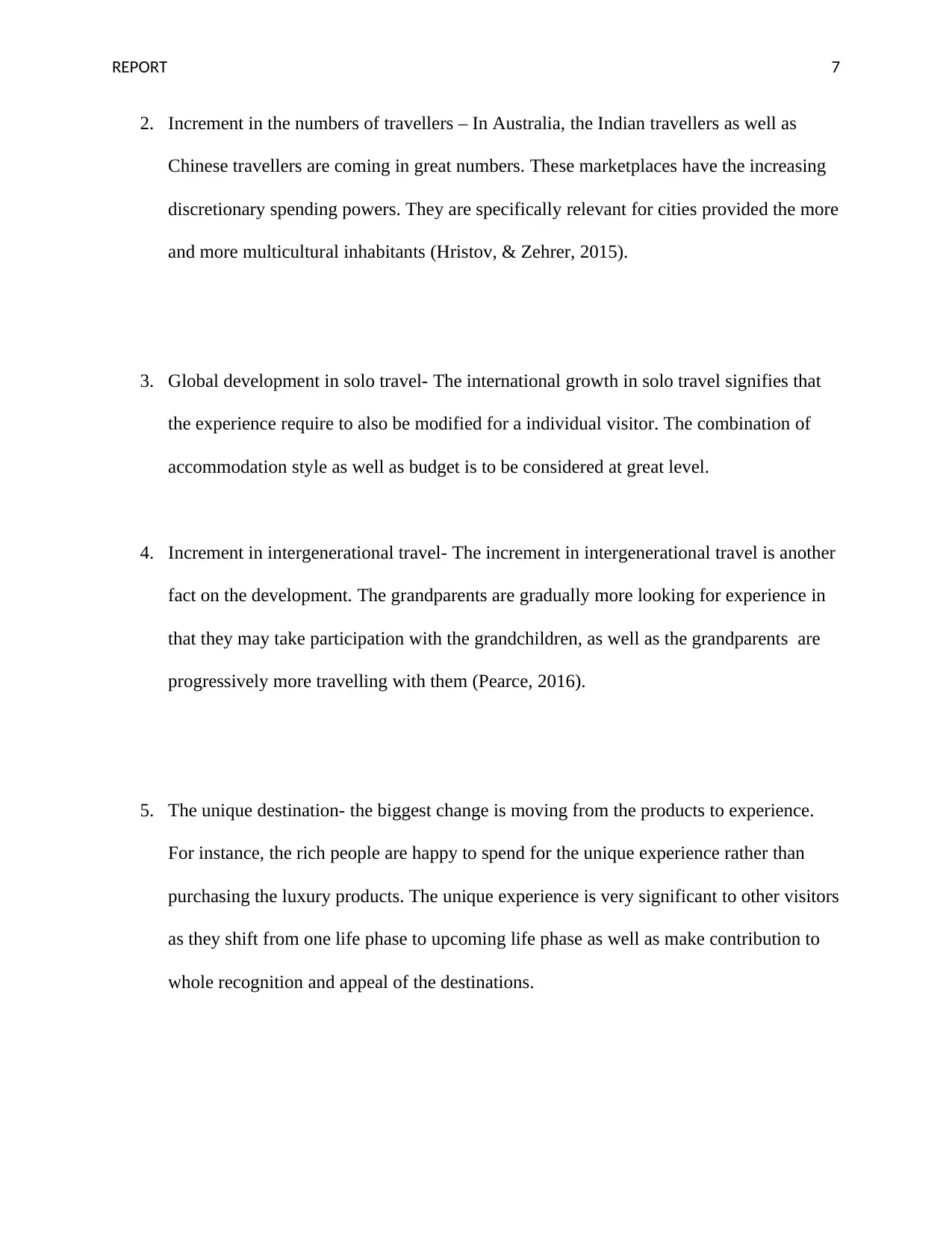
REPORT 7
2. Increment in the numbers of travellers – In Australia, the Indian travellers as well as
Chinese travellers are coming in great numbers. These marketplaces have the increasing
discretionary spending powers. They are specifically relevant for cities provided the more
and more multicultural inhabitants (Hristov, & Zehrer, 2015).
3. Global development in solo travel- The international growth in solo travel signifies that
the experience require to also be modified for a individual visitor. The combination of
accommodation style as well as budget is to be considered at great level.
4. Increment in intergenerational travel- The increment in intergenerational travel is another
fact on the development. The grandparents are gradually more looking for experience in
that they may take participation with the grandchildren, as well as the grandparents are
progressively more travelling with them (Pearce, 2016).
5. The unique destination- the biggest change is moving from the products to experience.
For instance, the rich people are happy to spend for the unique experience rather than
purchasing the luxury products. The unique experience is very significant to other visitors
as they shift from one life phase to upcoming life phase as well as make contribution to
whole recognition and appeal of the destinations.
2. Increment in the numbers of travellers – In Australia, the Indian travellers as well as
Chinese travellers are coming in great numbers. These marketplaces have the increasing
discretionary spending powers. They are specifically relevant for cities provided the more
and more multicultural inhabitants (Hristov, & Zehrer, 2015).
3. Global development in solo travel- The international growth in solo travel signifies that
the experience require to also be modified for a individual visitor. The combination of
accommodation style as well as budget is to be considered at great level.
4. Increment in intergenerational travel- The increment in intergenerational travel is another
fact on the development. The grandparents are gradually more looking for experience in
that they may take participation with the grandchildren, as well as the grandparents are
progressively more travelling with them (Pearce, 2016).
5. The unique destination- the biggest change is moving from the products to experience.
For instance, the rich people are happy to spend for the unique experience rather than
purchasing the luxury products. The unique experience is very significant to other visitors
as they shift from one life phase to upcoming life phase as well as make contribution to
whole recognition and appeal of the destinations.
Paraphrase This Document
Need a fresh take? Get an instant paraphrase of this document with our AI Paraphraser
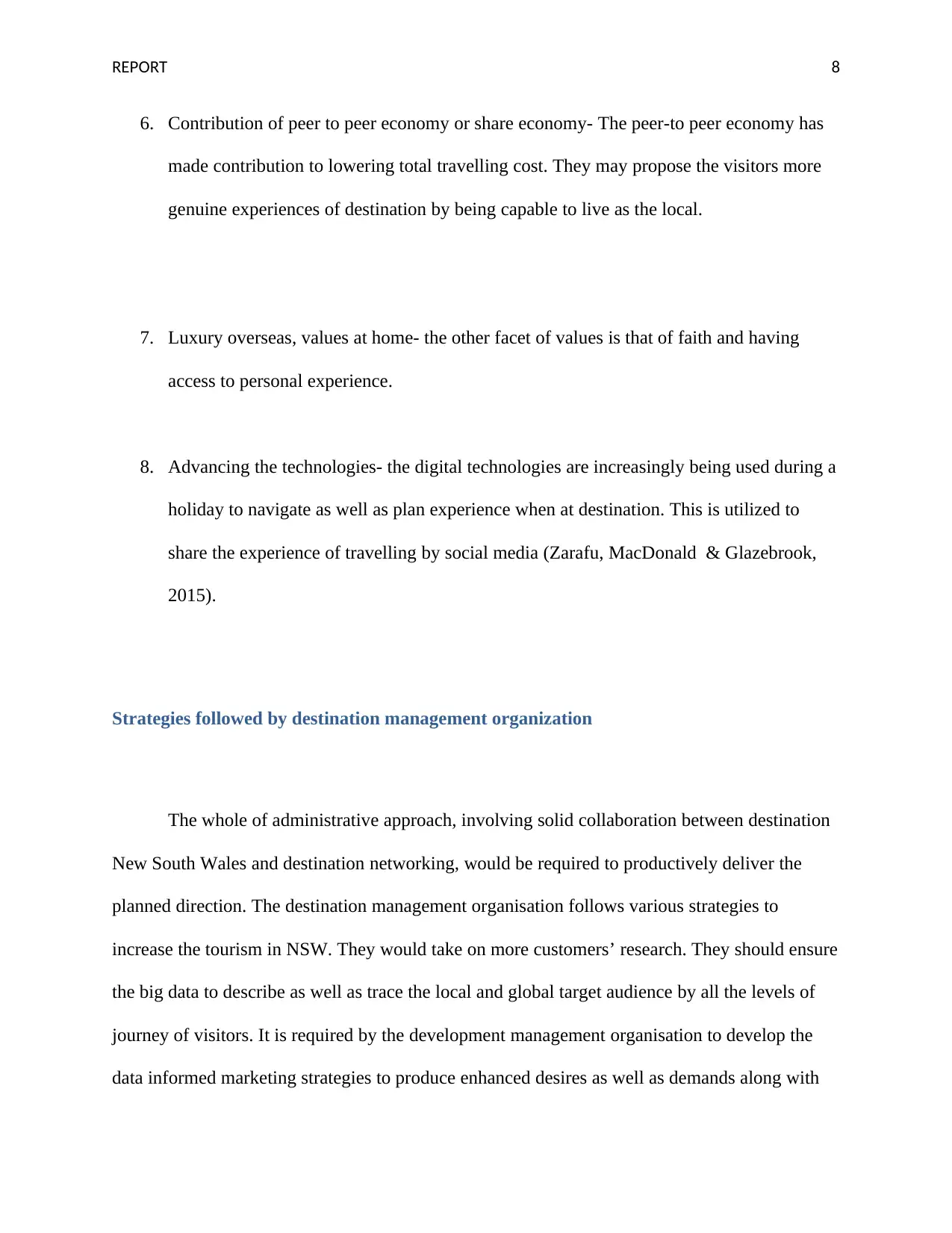
REPORT 8
6. Contribution of peer to peer economy or share economy- The peer-to peer economy has
made contribution to lowering total travelling cost. They may propose the visitors more
genuine experiences of destination by being capable to live as the local.
7. Luxury overseas, values at home- the other facet of values is that of faith and having
access to personal experience.
8. Advancing the technologies- the digital technologies are increasingly being used during a
holiday to navigate as well as plan experience when at destination. This is utilized to
share the experience of travelling by social media (Zarafu, MacDonald & Glazebrook,
2015).
Strategies followed by destination management organization
The whole of administrative approach, involving solid collaboration between destination
New South Wales and destination networking, would be required to productively deliver the
planned direction. The destination management organisation follows various strategies to
increase the tourism in NSW. They would take on more customers’ research. They should ensure
the big data to describe as well as trace the local and global target audience by all the levels of
journey of visitors. It is required by the development management organisation to develop the
data informed marketing strategies to produce enhanced desires as well as demands along with
6. Contribution of peer to peer economy or share economy- The peer-to peer economy has
made contribution to lowering total travelling cost. They may propose the visitors more
genuine experiences of destination by being capable to live as the local.
7. Luxury overseas, values at home- the other facet of values is that of faith and having
access to personal experience.
8. Advancing the technologies- the digital technologies are increasingly being used during a
holiday to navigate as well as plan experience when at destination. This is utilized to
share the experience of travelling by social media (Zarafu, MacDonald & Glazebrook,
2015).
Strategies followed by destination management organization
The whole of administrative approach, involving solid collaboration between destination
New South Wales and destination networking, would be required to productively deliver the
planned direction. The destination management organisation follows various strategies to
increase the tourism in NSW. They would take on more customers’ research. They should ensure
the big data to describe as well as trace the local and global target audience by all the levels of
journey of visitors. It is required by the development management organisation to develop the
data informed marketing strategies to produce enhanced desires as well as demands along with
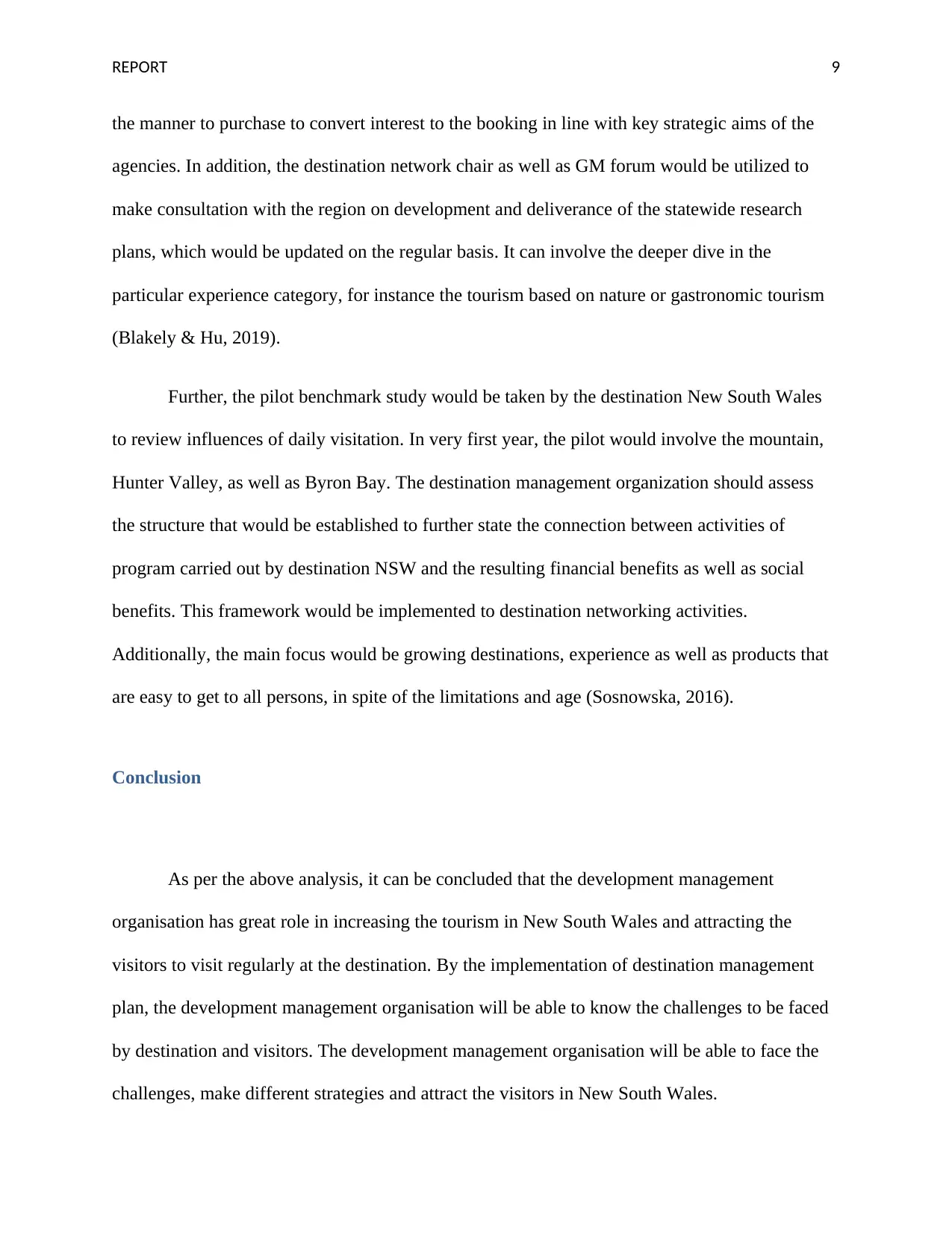
REPORT 9
the manner to purchase to convert interest to the booking in line with key strategic aims of the
agencies. In addition, the destination network chair as well as GM forum would be utilized to
make consultation with the region on development and deliverance of the statewide research
plans, which would be updated on the regular basis. It can involve the deeper dive in the
particular experience category, for instance the tourism based on nature or gastronomic tourism
(Blakely & Hu, 2019).
Further, the pilot benchmark study would be taken by the destination New South Wales
to review influences of daily visitation. In very first year, the pilot would involve the mountain,
Hunter Valley, as well as Byron Bay. The destination management organization should assess
the structure that would be established to further state the connection between activities of
program carried out by destination NSW and the resulting financial benefits as well as social
benefits. This framework would be implemented to destination networking activities.
Additionally, the main focus would be growing destinations, experience as well as products that
are easy to get to all persons, in spite of the limitations and age (Sosnowska, 2016).
Conclusion
As per the above analysis, it can be concluded that the development management
organisation has great role in increasing the tourism in New South Wales and attracting the
visitors to visit regularly at the destination. By the implementation of destination management
plan, the development management organisation will be able to know the challenges to be faced
by destination and visitors. The development management organisation will be able to face the
challenges, make different strategies and attract the visitors in New South Wales.
the manner to purchase to convert interest to the booking in line with key strategic aims of the
agencies. In addition, the destination network chair as well as GM forum would be utilized to
make consultation with the region on development and deliverance of the statewide research
plans, which would be updated on the regular basis. It can involve the deeper dive in the
particular experience category, for instance the tourism based on nature or gastronomic tourism
(Blakely & Hu, 2019).
Further, the pilot benchmark study would be taken by the destination New South Wales
to review influences of daily visitation. In very first year, the pilot would involve the mountain,
Hunter Valley, as well as Byron Bay. The destination management organization should assess
the structure that would be established to further state the connection between activities of
program carried out by destination NSW and the resulting financial benefits as well as social
benefits. This framework would be implemented to destination networking activities.
Additionally, the main focus would be growing destinations, experience as well as products that
are easy to get to all persons, in spite of the limitations and age (Sosnowska, 2016).
Conclusion
As per the above analysis, it can be concluded that the development management
organisation has great role in increasing the tourism in New South Wales and attracting the
visitors to visit regularly at the destination. By the implementation of destination management
plan, the development management organisation will be able to know the challenges to be faced
by destination and visitors. The development management organisation will be able to face the
challenges, make different strategies and attract the visitors in New South Wales.
⊘ This is a preview!⊘
Do you want full access?
Subscribe today to unlock all pages.

Trusted by 1+ million students worldwide
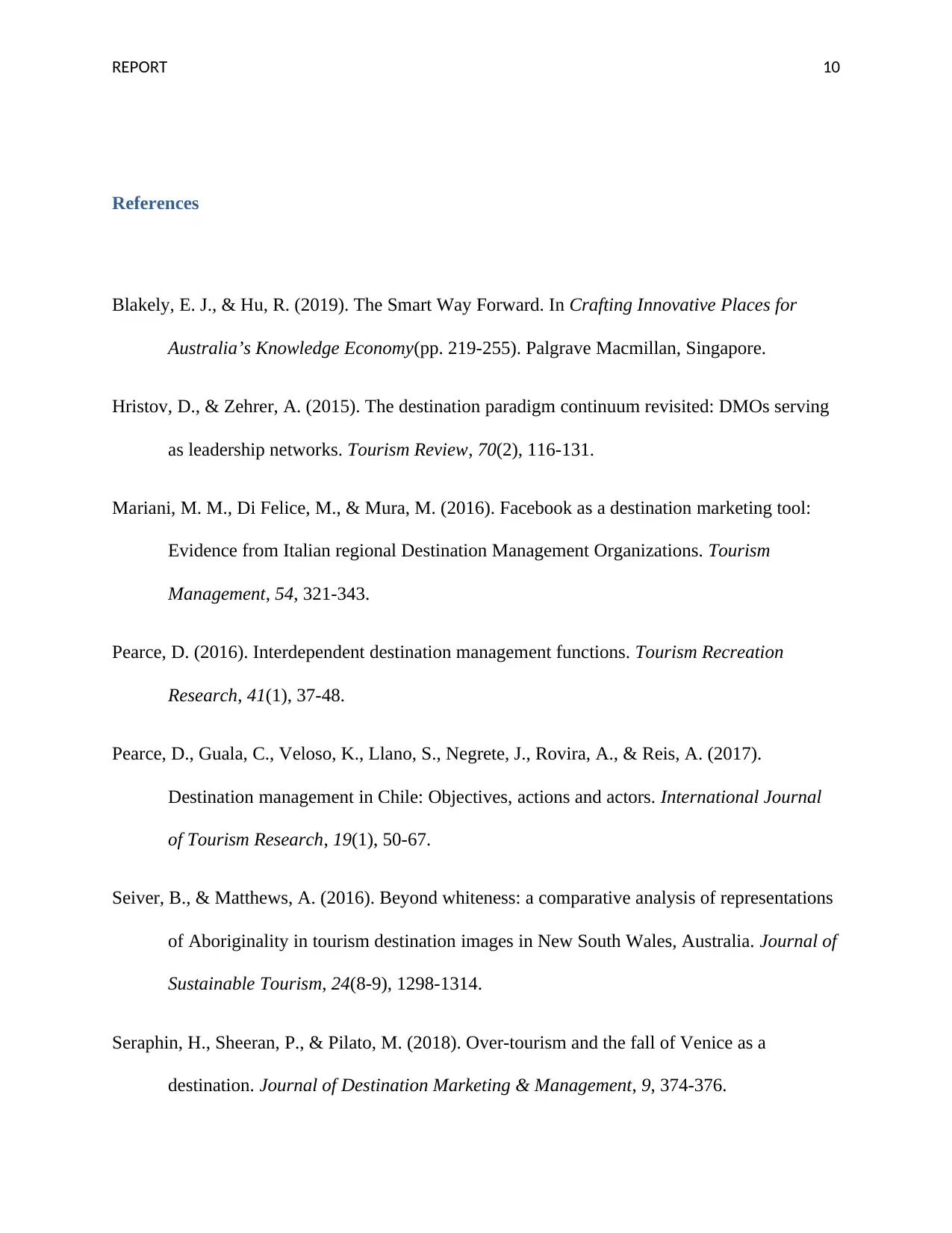
REPORT 10
References
Blakely, E. J., & Hu, R. (2019). The Smart Way Forward. In Crafting Innovative Places for
Australia’s Knowledge Economy(pp. 219-255). Palgrave Macmillan, Singapore.
Hristov, D., & Zehrer, A. (2015). The destination paradigm continuum revisited: DMOs serving
as leadership networks. Tourism Review, 70(2), 116-131.
Mariani, M. M., Di Felice, M., & Mura, M. (2016). Facebook as a destination marketing tool:
Evidence from Italian regional Destination Management Organizations. Tourism
Management, 54, 321-343.
Pearce, D. (2016). Interdependent destination management functions. Tourism Recreation
Research, 41(1), 37-48.
Pearce, D., Guala, C., Veloso, K., Llano, S., Negrete, J., Rovira, A., & Reis, A. (2017).
Destination management in Chile: Objectives, actions and actors. International Journal
of Tourism Research, 19(1), 50-67.
Seiver, B., & Matthews, A. (2016). Beyond whiteness: a comparative analysis of representations
of Aboriginality in tourism destination images in New South Wales, Australia. Journal of
Sustainable Tourism, 24(8-9), 1298-1314.
Seraphin, H., Sheeran, P., & Pilato, M. (2018). Over-tourism and the fall of Venice as a
destination. Journal of Destination Marketing & Management, 9, 374-376.
References
Blakely, E. J., & Hu, R. (2019). The Smart Way Forward. In Crafting Innovative Places for
Australia’s Knowledge Economy(pp. 219-255). Palgrave Macmillan, Singapore.
Hristov, D., & Zehrer, A. (2015). The destination paradigm continuum revisited: DMOs serving
as leadership networks. Tourism Review, 70(2), 116-131.
Mariani, M. M., Di Felice, M., & Mura, M. (2016). Facebook as a destination marketing tool:
Evidence from Italian regional Destination Management Organizations. Tourism
Management, 54, 321-343.
Pearce, D. (2016). Interdependent destination management functions. Tourism Recreation
Research, 41(1), 37-48.
Pearce, D., Guala, C., Veloso, K., Llano, S., Negrete, J., Rovira, A., & Reis, A. (2017).
Destination management in Chile: Objectives, actions and actors. International Journal
of Tourism Research, 19(1), 50-67.
Seiver, B., & Matthews, A. (2016). Beyond whiteness: a comparative analysis of representations
of Aboriginality in tourism destination images in New South Wales, Australia. Journal of
Sustainable Tourism, 24(8-9), 1298-1314.
Seraphin, H., Sheeran, P., & Pilato, M. (2018). Over-tourism and the fall of Venice as a
destination. Journal of Destination Marketing & Management, 9, 374-376.
Paraphrase This Document
Need a fresh take? Get an instant paraphrase of this document with our AI Paraphraser
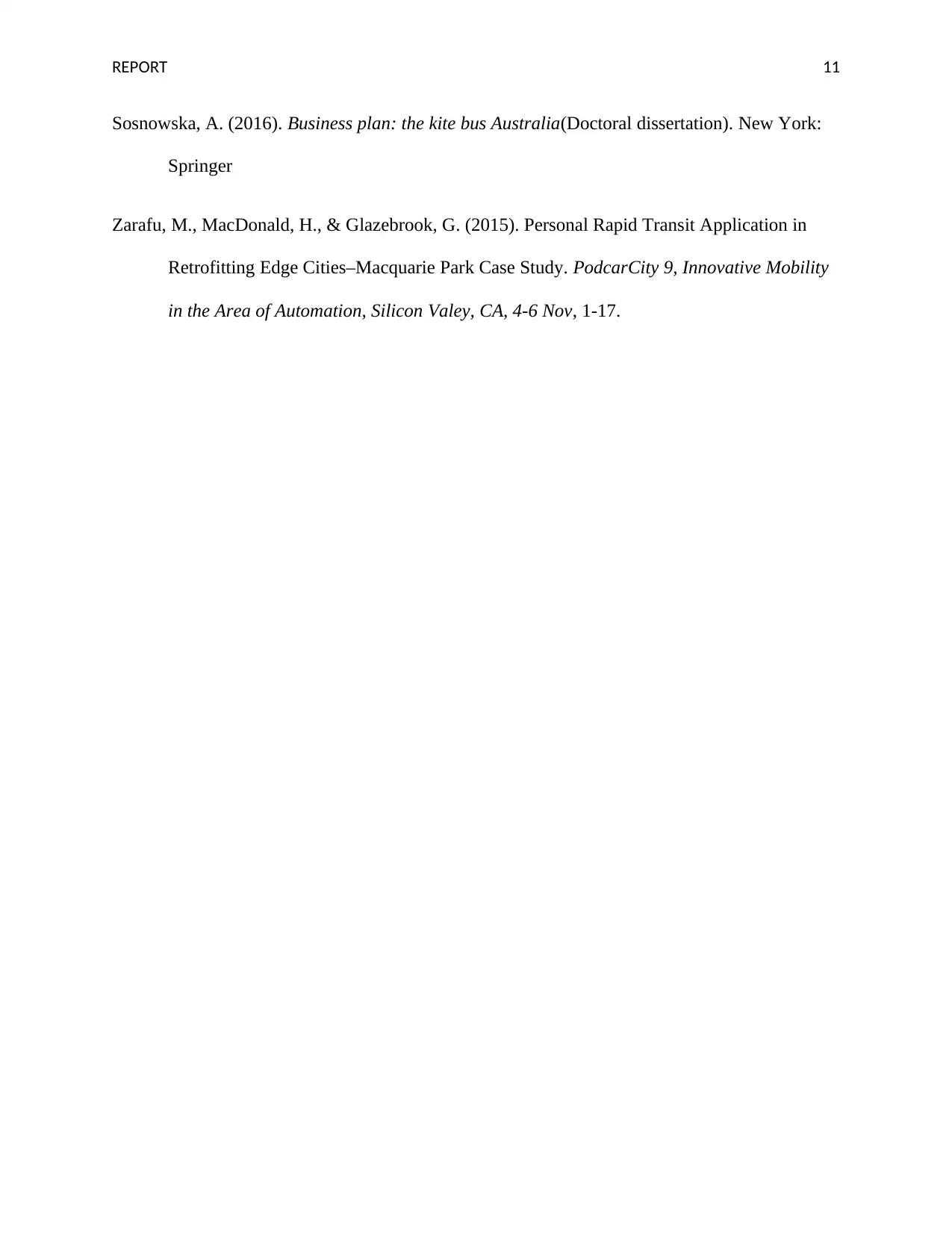
REPORT 11
Sosnowska, A. (2016). Business plan: the kite bus Australia(Doctoral dissertation). New York:
Springer
Zarafu, M., MacDonald, H., & Glazebrook, G. (2015). Personal Rapid Transit Application in
Retrofitting Edge Cities–Macquarie Park Case Study. PodcarCity 9, Innovative Mobility
in the Area of Automation, Silicon Valey, CA, 4-6 Nov, 1-17.
Sosnowska, A. (2016). Business plan: the kite bus Australia(Doctoral dissertation). New York:
Springer
Zarafu, M., MacDonald, H., & Glazebrook, G. (2015). Personal Rapid Transit Application in
Retrofitting Edge Cities–Macquarie Park Case Study. PodcarCity 9, Innovative Mobility
in the Area of Automation, Silicon Valey, CA, 4-6 Nov, 1-17.
1 out of 11
Related Documents
Your All-in-One AI-Powered Toolkit for Academic Success.
+13062052269
info@desklib.com
Available 24*7 on WhatsApp / Email
![[object Object]](/_next/static/media/star-bottom.7253800d.svg)
Unlock your academic potential
Copyright © 2020–2025 A2Z Services. All Rights Reserved. Developed and managed by ZUCOL.





